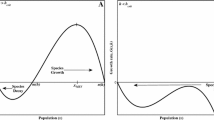Abstract
An important public policy question that remains unresolved iswhether devolution will enhance sensible policy making byexploiting informational asymmetries or, instead, trigger a``beggar thy neighbor'' response and stimulate free ridingamongst localities. We analyze this question within theframework of U.S. environmental policymaking by scrutinizing aunique panel data set on state-level endangered speciesexpenditure patterns. Our empirical estimates are consistentwith the notion that states free ride, which may lead to anexpenditure equilibrium that is not Pareto efficient.
Similar content being viewed by others
References
Boadway, R., Horiba, I and Raghbendrajha, J. (1999). The provision of public services by government funded decentralized agencies. Public Choice 100: 157–184.
Brown, R. and Garner, L. (1998). Resource guide to state environmental management. Lexington, KY: The Council of State Governments.
Brown, R.J. and Marshall, K. (1990). Resource guide to state environmental management. Lexington, KY: The Council of State Governments.
Fraserinstitute (1999). Crying wolf? Public policy on endangered species. 1999 Critical issues, www.fraserinstitute.ca/publications
Hewitt, J.A. and Brown, D. (2000). Agency costs in environmental not-for-profits. Public Choice 103: 163–183.
List, J.A. (2001). Do explicit warnings eliminate the hypothetical bias in elicitation procedures? Evidence from field auctions for sportscards. American Economic Review, forthcoming.
List, J.A. and Gerking, S. (2000). Regulatory federalism and U.S. environmental policies. Journal of Regional Science, forthcoming.
Mann, C. and Plummer, M. (1993). Federal expenditures on endangered species recovery. Discovery Institute, Seattle.
Merrifield, J. (1996). A market approach to conserving biodiversity. Ecological Economics 16: 217–226.
Merrifield, J. (2000). State government expenditure determinants and tax revenue determinants revisited. Public Choice 102: 25–50.
Metrick, A. and Weitzman, M.L. (1996). Patterns of behavior in endangered species preservation. Land Economics 72: 1–16.
Metrick, A. and Weitzman, M.L. (1998). Conflicts and choices in biodiversity preservation. Journal of Economic Perspectives 12: 21–34.
Nathan R. and Doolittle, F. (1983). The consequences of cuts: The effects of the Reagan domestic program on state and local governments. Princeton University Press, Princeton, New Jersey.
Oates, W. (1991). Studies in fiscal federalism. Brookfield, VT: E. Elgar.
Petersen, S. (1999). Congress and charismatic megafauna: A legislative history of the Endangered Species Act. Environmental Law. Northwestern School of Law of Lewis and Clark College, Summer.
Primack, R.B. (1998). Essentials of conservation biology 2nd edition. Sunderland: Sinauer.
Samuelson, P. (1954). The pure theory of public expenditures. Review of Economics and Statistics 36: 387–389.
Shogren, J. and Brown, G. (1998). Economics of the Endangered Species Act. Journal of Economic Perspectives 12: 3–20.
Smith, R.J. (1999). Repeal the Endangered Species Act. Human Events 55: 12.
Weitzman M.L. (1992). On diversity. Quarterly Journal of Economics 107: 363–405.
Weitzman M.L. (1993). What to preserve? An application of diversity theory to Crane conservation. Quarterly Journal of Economics 108: 157–183.
Weitzman M.L. (1998). The Noah's ark problem. Econometrica 66: 1279–1298.
Wilson J.D. (1996). Capital mobility and environmental standards: Is there a theoretical basis for a race to the bottom. In J. Bhagwati and R.P. Hudec (Eds.), Fair trade and harmonization: Prerequisites for free trade, Vol. I. Cambridge and London: MIT Press.
Author information
Authors and Affiliations
Rights and permissions
About this article
Cite this article
List, J.A., Bulte, E.H. & Shogren, J.F. “Beggar thy Neighbor:” Testing for Free Riding in State-Level Endangered Species Expenditures. Public Choice 111, 303–315 (2002). https://doi.org/10.1023/A:1014947110729
Issue Date:
DOI: https://doi.org/10.1023/A:1014947110729




